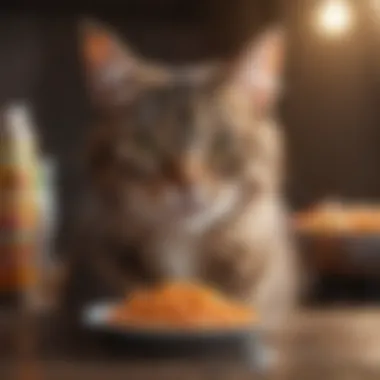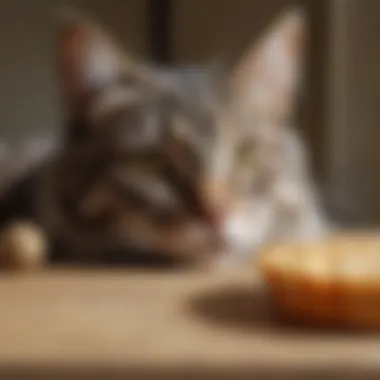Feline Kidney Diet: Benefits of Canned Food for Cats


Intro
Understanding the dietary needs of cats with kidney issues is crucial for their health management. A specialized diet can greatly influence their quality of life. This article delves into the implications of feeding canned food to felines suffering from renal disease. We will discuss the nutritional requirements, ingredients, moisture content, and more, assisting pet owners in making informed decisions to support their cats.
Animal Profile
General Overview
Cats, particularly domestic cats, are obligate carnivores, needing specific nutrients that are typically found in animal-based food. For cats with kidney disease, their dietary requirements shift subtly. A significant number of felines, especially as they age, face kidney health issues. The kidneys play vital roles in filtering waste, regulating blood pressure, and maintaining hydration. Thus, the food they consume needs to be tailored to support these functions.
Habitat and Distribution
Cats are widespread across the globe, commonly found in homes, cities, and rural areas. Felines can adapt to various environments, but their natural instincts drive them to hunt and thrive in settings where they can pursue prey. Although domestication has altered their lifestyle, the fundamental aspects of their biology remind us of their wild ancestry.
Importance of Canned Food
Canned food serves as a beneficial option for cats with kidney issues. It offers:
- Increased moisture content, essential for kidney function
- Easily digestible proteins
- Lower phosphorus levels, important for managing kidney disease
- A variety of flavors, promoting food intake in picky eaters
Canned food can help maintain hydration, which is crucial, as dehydration can exacerbate kidney issues.
Proper hydration is essential for maintaining kidney health in cats.
Ingredients Considerations
When selecting canned food, ingredients play a significant role. Look for high-quality animal protein sources, minimal fillers, and no artificial additives. Ingredients such as chicken, turkey, and fish are preferred, as well as hydrolyzed proteins that are gentle on the kidneys.
Common Concerns from Pet Owners
Pet owners often express several concerns regarding diet and kidney disease. Common topics include:
- Cost of specialized food: While prescription diets can be more expensive, their long-term benefits may outweigh the initial costs.
- Transitioning diets: Introducing new food to a cat's diet can be challenging. Gradual changes can help ease their adaptation.
- Choosing the right product: It's crucial to consult with a veterinarian to select the best canned food option tailored to their cat's specific needs.
Meal Planning Guidelines
Proper meal planning is necessary to manage a cat's kidney health effectively. Here are some tips:
- Serve multiple small meals daily to improve digestibility and nutrient absorption.
- Include wet food options at every meal to increase moisture intake.
- Monitor their weight regularly and adjust portion sizes accordingly.
- Always provide fresh water available at all times, even if they are fed wet food.
Relationship Between Diet and Quality of Life
A well-planned diet significantly influences a cat’s overall well-being. Cats with appropriate food selections experience better kidney function, maintained hydration, and improved energy levels. Such changes can lead to a healthier, happier feline.
Educating pet owners on these aspects fosters informed decision-making that prioritizes the health of their cherished companions. The goal is to ensure that every cat with kidney challenges can enjoy as high a quality of life as possible.
Understanding Feline Kidney Disease
Feline kidney disease is a significant health issue that affects a large number of cats, especially as they age. It is crucial to understand this condition for several reasons. Firstly, kidney disease in cats often goes undiagnosed until it reaches advanced stages. Early detection can lead to more effective management and improved quality of life. By acknowledging this issue, pet owners can take proactive measures to support their cat’s health through dietary adjustments and veterinary care.
Moreover, kidney disease can impact various physiological processes, making it essential to recognize its implications. A well-informed approach can help in choosing the right dietary options, especially regarding canned food, which plays a critical role in managing this condition.
What is Feline Kidney Disease?
Feline kidney disease, often referred to as chronic kidney disease (CKD), is a gradual loss of kidney function over time. The kidneys perform vital tasks such as filtering waste from the blood, balancing electrolytes, and regulating blood pressure. When a cat's kidneys become damaged, these functions decline. This leads to the accumulation of toxins in the bloodstream and various health issues for the cat.


Chronic kidney disease is different from acute kidney injury, which may be reversible. CKD is typically progressive, and its management focuses on slowing down the progression and providing a better quality of life for the affected cat. As kidney function decreases, various systemic changes occur, making it imperative for pet owners to monitor kidney health closely.
Causes of Kidney Disease in Cats
Several factors contribute to the development of feline kidney disease. Some of the most common causes include:
- Aging: Older cats are more prone to developing kidney disease as kidney function naturally declines with age.
- Genetics: Some breeds, such as Maine Coons and Abyssinians, are predisposed to kidney issues due to hereditary factors.
- Dietary Factors: Poor nutrition, particularly diets high in phosphorus or low in moisture, can lead to kidney strain over time.
- Chronic Conditions: Diseases such as diabetes mellitus, hypertension, or hyperthyroidism can also affect kidney health.
- Toxins and Medications: Exposure to specific toxins and certain medications can cause acute kidney injury and may lead to chronic issues later on.
Understanding these causative factors is crucial for prevention and management strategies.
Symptoms to Watch For
Recognizing the symptoms of kidney disease in cats is essential for timely intervention. Common signs include:
- Increased thirst and urination
- Decreased appetite or weight loss
- Vomiting
- Lethargy and decreased activity levels
- Poor coat condition or grooming habits
These symptoms may not appear until the disease is quite advanced. Therefore, regular veterinary check-ups are vital in monitoring kidney health and ensuring prompt action if any symptoms arise. If noticed early, dietary interventions, particularly the incorporation of canned food, can significantly improve a cat's overall well-being and slow the progression of kidney disease.
Regular monitoring and understanding of kidney health are vital components in managing feline kidney disease. Adjusting diet, especially to include hydrating foods like canned food, can lead to better outcomes.
Nutritional Needs for Cats with Kidney Issues
Nutritional needs for cats with kidney issues form a critical aspect of managing their health and wellbeing. As renal disease progresses, a cat's ability to process certain nutrients diminishes. Therefore, careful attention to dietary adjustments is essential. The right diet can help mitigate further damage to the kidneys, enhance the overall health of the feline, and even prolong their life expectancy. This section aims to elucidate the importance of dietary modifications, highlight key nutrients, and discuss the limitations of certain ingredients in a renal-friendly diet.
Importance of Dietary Adjustments
Dietary adjustments are vital when dealing with kidney disease in cats. As the condition worsens, the kidneys lose their ability to filter waste from the blood effectively. Consequently, a specialized diet becomes necessary to manage these changes.
Adapting a cat’s diet can significantly impact kidney function and overall energy levels. A lower protein intake is often recommended, but proteins must also be high-quality to support the cat's muscle mass and minimize waste in the kidneys.
Additionally, tailored diets can reduce phosphorus levels, which when elevated can cause further renal complications, making dietary changes an essential part of managing feline kidney disease. Working closely with a veterinarian to ensure these adjustments are appropriate is central to maintaining your cat's health.
Key Nutrients Required
Specific nutrients play crucial roles in the dietary management of kidney disease in cats. Some of these include:
- High-quality proteins: While protein intake must be controlled, these should be of superior quality to avoid excess waste production. Sources like chicken or fish are often preferred.
- Adequate moisture: Canned food provides essential hydration, aiding in kidney function. It becomes imperative for cats facing potential dehydration that often comes with kidney disease.
- Omega-3 fatty acids: These can help reduce inflammation and improve overall kidney function. Fish oil is a well-regarded source.
- B Vitamins: Particularly B12, these nutrients support the metabolic processes that may be hindered by kidney dysfunction.
These nutrients collectively play an essential role in helping maintain the health of a cat with kidney issues. They contribute to cellular function, hydration, and overall well-being, thus reducing stress on the kidneys.
Limitations on Certain Ingredients
Choosing the right food also involves recognizing the limitations of certain ingredients. It is critical to limit the intake of:
- Phosphorus: Many commercial pet foods contain high levels of phosphorus, which can exacerbate kidney disease.
- Sodium: High sodium levels can lead to hypertension and accelerate kidney dysfunction.
- Unnecessary fillers: Ingredients such as corn, soy, or by-products can offer little nutritional value and may produce excess waste.
Understanding these limitations will help owners make informed choices that directly support their cat's health. Regular consultation with a veterinarian can help to navigate ingredient selection effectively.
The right diet can be instrumental in managing feline kidney disease, directly impacting health and vitality.
Benefits of Canned Food for Kidney Health
Canned food offers several advantages for cats suffering from kidney issues. The importance of including this type of diet in managing feline kidney disease cannot be overstated. Kidney health is closely tied to hydration and nutrient intake, both of which are essential for managing the condition. Canned food plays a significant role in ensuring that cats receive an adequate intake of water and essential nutrients that support their overall health. In view of these factors, it is vital to explore the distinct benefits that canned food provides for kidney health.
Moisture Content and Hydration
One of the most significant benefits of canned food is its high moisture content. Cats are often not good at drinking sufficient water, which can lead to dehydration. For a cat with kidney disease, maintaining hydration is crucial. The kidneys function best when they have enough fluid to filter waste products effectively.


Canned food typically contains around 70-80% water, unlike dry kibble that may contain only 10%. This difference means that even if a cat does not drink much water, the moisture in canned food can help keep them hydrated. Proper hydration aids in the dilution of waste products in the bloodstream and reduces the workload on the kidneys.
Hydrated cats are less prone to urinary issues and dehydration-related complications.
Palatability for Cats
Taste is an important factor when selecting a diet for cats with kidney disease. A highly palatable diet encourages cats to eat more. Many cats experience a decreased appetite due to illness, making it essential to provide food they enjoy.
Canned food generally has a stronger aroma and taste compared to dry food. This characteristic can entice cats to eat more consistently, which is vital for maintaining their strength and health. When cats eat sufficient amounts, they are more likely to meet their nutritional needs. Furthermore, varieties of canned food come in different flavors and textures, allowing owners to find options that appeal to their individual cat's preferences.
Easier Digestion
Dietary choices become more critical with kidney issues. Canned food tends to be easier to digest compared to dry food. The softer texture of canned food makes it less taxing for the gastrointestinal tract, which can be beneficial for cats with sensitive stomachs or those recovering from other health issues.
Moreover, the formulations of many canned foods intended for kidney management often include high-quality proteins and reduced phosphorus levels. These aspects not only cater to kidney health but also aid overall digestion. A diet that supports both the kidneys and digestive function can make a notable difference in a cat's well-being and quality of life.
In summary, canned food provides important benefits for cats with kidney health concerns. Its moisture content promotes hydration, palatability encourages better eating habits, and its ease of digestion supports overall nutritional intake. These factors collectively contribute to managing feline kidney disease effectively.
Evaluating Canned Food Options
Evaluating canned food options is essential for managing the dietary needs of cats with kidney issues. The quality of food plays a vital role in their overall wellbeing. When it comes to selecting the appropriate canned food, several factors demand attention. Not only do pet owners need to consider the ingredient list, but they also should focus on the specific nutritional requirements related to kidney health.
The right canned food can offer advantages such as optimum moisture content, improved palatability, and better digestibility. These factors contribute significantly to managing kidney disease in felines. Moreover, informed decisions on food choices empower pet owners to enhance the quality of life for their pets in need of special dietary care.
Label Reading: What to Look For
When reading labels, certain elements stand out that help determine if a canned food is suitable for a cat with kidney issues. Here are important points to consider:
- Protein Source: High-quality protein is crucial. Look for specific proteins like chicken, turkey, or fish listed at the top of the ingredient list. Avoid generic terms such as
Common Concerns with Feline Kidney Diets
In managing kidney disease in cats, dietary choices play a significant role. However, pet owners often face concerns that can complicate the transition to a specialized diet. This section addresses those common concerns, highlighting specific elements, benefits, and considerations regarding cats' diets focused on kidney health.
Transitioning Between Foods
Changing a cat’s diet can be a delicate process. Felines are creatures of habit, so introducing canned food can lead to resistance. A gradual transition is crucial to minimize gastrointestinal upset. Start by mixing small amounts of new food with the current food.
- Begin with a ratio such as 25% canned food to 75% current food, gradually increasing the amount of canned food over seven to ten days.
- Monitor for any adverse reactions such as vomiting or diarrhea.
- If issues arise, slow down the transition rate. It is important that cats feel comfortable with their food to ensure they receive the necessary nutrition.
Potential Health Risks
While a kidney-friendly diet can improve the quality of life, it does come with potential health risks. These can arise from both improper dietary choices and transition mishaps. Here are some risks to consider:
- Inadequate Nutrition: Not all canned foods are formulated with the right balance of protein, phosphorus, and moisture that are essential for kidney cats. It’s critical to choose high-quality options.
- Weight Management: Sudden dietary changes can lead to weight fluctuations, causing stress on an already compromised system. Consult with a veterinarian to create a plan suitable for your cat’s needs.
- Dehydration Risks: Some pet owners may mistakenly think that switching to canned food alone ensures hydration. However, monitoring water intake remains important.
A well-balanced diet tailored for kidney health can mitigate many of these risks, but attention to details is essential.
Cost Considerations
Feeding cats with kidney disease often results in increased feeding costs. High-quality canned foods typically come with a higher price tag compared to regular cat foods. While pet owners might find the expense concerning, consider the long-term health benefits:
- Quality over Quantity: Investing in premium canned foods designed for kidney health may prevent expensive veterinary interventions in the future.
- Bulk Buying Opportunities: Many manufacturers offer bulk pricing or subscriptions, which can help offset cost challenges.
- Comparative Cost Analysis: Evaluate your existing budget for pet care and compare it with the potential long-term health benefits of investing in better food options.
Meal Planning for Cats with Kidney Disease
Meal planning for cats with kidney disease is critical for supporting their health and improving their quality of life. The right dietary approach helps manage the symptoms of kidney issues, enhances hydration, and ensures that essential nutrients are provided. Proper meal planning considers various aspects of a cat's diet, including protein, phosphorus, and moisture content. It is important for pet owners to engage in this process, as it can significantly affect their cat’s wellbeing.


Creating a Balanced Diet
Creating a balanced diet for cats with kidney disease requires careful selection of food ingredients. A balanced diet generally includes a right mix of macronutrients: proteins, fats, and carbohydrates, along with vitamins and minerals. It is also essential to maintain a low phosphorus level, as excess phosphorus can worsen kidney function.
Key Components for a Balanced Diet:
- High-Quality Protein Sources: Cats need protein, but it should be sourced from animal products that are easy to digest. Chicken and turkey are often good options.
- Reduced Phosphorus: Lower amounts of phosphorus are necessary to prevent further deterioration of kidney health. Look for foods specifically designed for kidney support.
- Healthy Fats: Fats provide energy and should come from sources like fish oil or chicken fat, which can also support a cat’s skin and coat health.
- Hydration: Canned food is vital as it contains higher moisture compared to dry food. This helps keep cats hydrated, which is beneficial for their kidneys.
Always consult a veterinarian to get personalized recommendations based on your cat's specific health needs.
Portion Control and Feeding Frequency
Portion control and feeding frequency play a significant role in managing a cat's dietary intake, especially for those with kidney issues. It is important to monitor how much your cat eats and when to feed them. Overfeeding can lead to obesity, which adds additional stress on kidneys.
Suggestions for Portion Control and Feeding Frequency:
- Frequent Small Meals: Instead of one or two large meals, consider feeding smaller portions multiple times a day. This regular intake supports digestion and makes it easier to manage nutrient absorption.
- Use a Measuring Tool: Using measuring cups can help ensure you are providing the right portions of food widely recommended by the vet.
- Observe Eating Patterns: Monitoring your cat's eating habits can help you adjust portions effectively. If your cat seems uninterested in food, it might require a different flavor or type of food.
- Veterinary Guidance: Regular consultations with a veterinarian will offer insights into the appropriate meal sizes and frequencies, ensuring your cat stays healthy.
In summary, careful meal planning, focusing on a balanced diet and appropriate portion control, is pivotal in managing a cat with kidney disease. This structured approach can greatly enhance your pet’s quality of life.
Monitoring Health and Progress
Monitoring the health of cats with kidney disease is crucial for their well-being. Regular assessment helps in understanding how well a dietary plan is working. It allows pet owners to make informed choices concerning the nutritional needs of the cat. This also ensures that any changes in health status are promptly addressed.
Regular Veterinary Check-ups
Regular veterinary check-ups play an essential role in the ongoing care of cats with kidney issues. These visits provide an opportunity for veterinarians to assess the overall health of the cat and keep track of kidney function. Blood tests can measure important markers such as blood urea nitrogen and creatinine levels. This information offers insight into how effectively the kidneys are functioning.
Moreover, veterinarians can offer tailored advice based on the individual pet's health status. They may suggest adjustments to the diet or recommend specific canned food brands that align better with the current needs of the cat's health condition. After each check-up, both owners and veterinarians can jointly determine the most effective management strategies.
Adjusting Diet as Needed
Adjusting the diet is an important aspect of managing kidney disease in cats. As the condition of the cat progresses, its nutritional needs may change. Understanding these needs allows for a more effective dietary approach.
There can be specific times when adjustments are needed, such as:
- Changes in blood work results.
- Shifts in the cat's appetite or eating habits.
- Any visible symptoms that escalate or appear.
Consulting a veterinarian can help pet owners determine if canned food options should be modified or if new nutrients should be introduced. This ongoing evaluation is critical. A suitable diet not only makes the cat feel better but also improves its quality of life. Ultimately, monitoring health and making dietary adjustments ensure that the feline stays as healthy as possible throughout its condition.
The Impact of Diet on Quality of Life
Diet plays a crucial role in the overall well-being of felines, particularly those grappling with kidney disease. An optimized diet can significantly influence their health and comfort, providing essential nutrients and hydration. Proper dietary management helps in minimizing the symptoms of kidney issues while supporting the cat's remaining kidney function.
Long-term Management Strategies
Implementing effective long-term management strategies is vital for cats with kidney disease. The primary aim is to slow the progression of the disease and enhance the quality of life.
Key strategies include:
- Dietary Adjustments: Selecting a suitable commercial canned food formulated for kidney health can help. These foods typically lower protein but enhance quality, making digestion easier.
- Hydration Focus: Canned food inherently provides more moisture compared to dry food. This feature is critical as hydration is a key concern in managing kidney disease. Encourage water intake by incorporating wet food in their diet and considering additional water sources.
- Regular Monitoring: Routine veterinary check-ups are necessary to assess the cat’s kidney function. Adjustments to the dietary plan may be required based on their health developments.
- Supplements: Consult your veterinarian about the use of supplements. Certain vitamins and minerals can help support kidney health.
These strategies collectively contribute to a structured approach that can sustainably maintain the cat's vitality.
Signs of Improved Health
Monitoring for signs of improved health is essential for validating the effectiveness of dietary changes. Positive changes can indicate that the current management plan is beneficial.
Common indicators include:
- Increased Energy Levels: A noticeable boost in activity or playfulness can suggest that the dietary modifications are helping.
- Improved Appetite: If a cat starts showing interest in food again, it can point towards a more positive health status. This is especially relevant when introducing canned food, which is often more palatable.
- Better Hydration: Adequate water intake shows through clearer urine output and a more active drinking routine. Cats that may have been dehydrated previously should show improvements in their hydration habits.
- Weight Stability: Maintaining a stable weight, particularly in the face of kidney disease, implies effective nutritional support and management.
Overall, these signs help pet owners understand the effectiveness of their chosen diet and lifestyle adjustments, leading to ongoing commitment to the cat's health.















